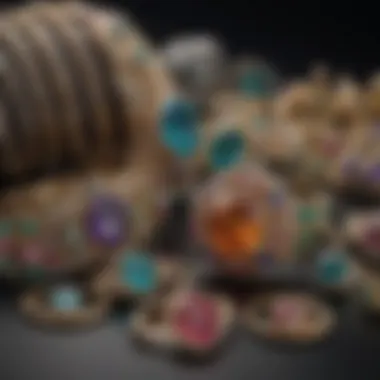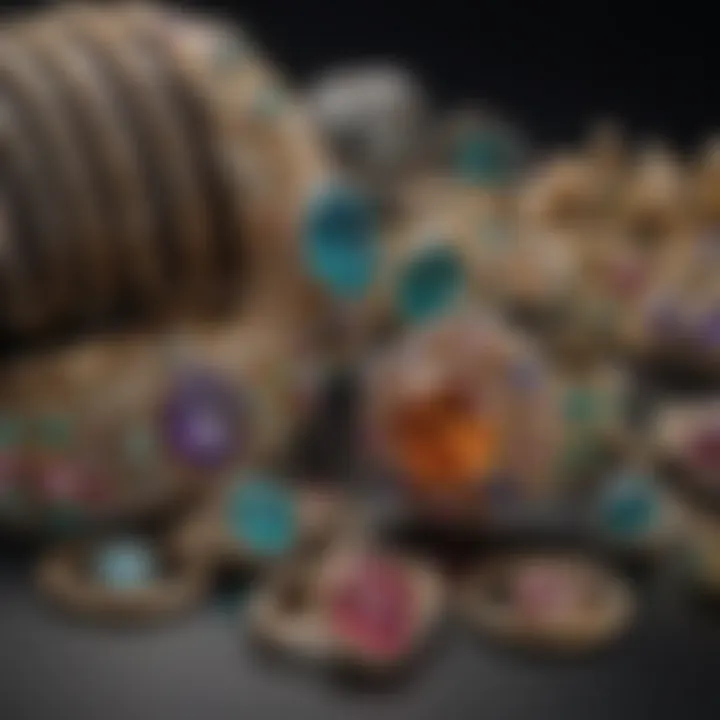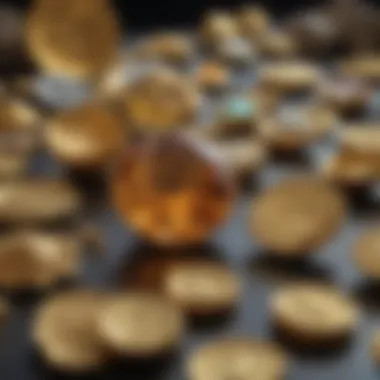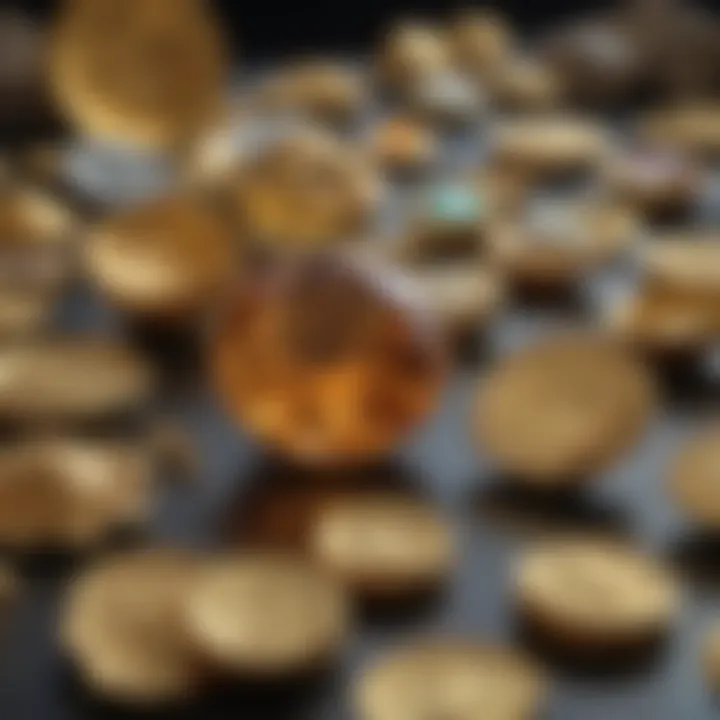Understanding Karat: The Purity of Gold Explained


Intro
Karat, a term that refers not only to the weight of gemstones but also to the purity of gold, is crucial for both jewelers and clients alike. As someone who endeavors to acquire beautiful pieces of jewelry, understanding karat can spare you from falling victim to misleading claims and make you a more informed buyer. It is one of those topics that often gets glossed over in casual conversations but holds far more significance than one might initially think.
In this article, we will break down the essence of karat, covering its definition, historical roots, and significance in the jewelry market. We'll also touch upon different levels of karat, their symbolism, and how they can greatly affect the value of jewelry. As we journey through these facets of karat, we hope to arm you with the knowledge needed to navigate the often murky waters of gold purchasing and appreciation.
Gemstone Overview
Definition and Origins
The word "karat," derived from the carob seeds historically used to weigh precious gems, encapsulates the concept of purity. In today’s usage, karat (often abbreviated as "kt") denotes the proportion of gold in an alloy. Pure gold is classified as 24-karat gold, meaning that it has no other metals mixed in. Other karat levels such as 18K, 14K, and 10K indicate various blends of gold with metals like silver, copper, or palladium.
These mixtures serve multiple purposes, including enhancing strength, improving color, and making the metal more affordable. A piece of jewelry labeled as 18K contains 75% gold and 25% other metals, making it more durable than its pure counterpart, albeit with some sacrifice in purity.
Historical Significance
Throughout history, the standards by which karats have been determined have varied globally, shaped by cultures and technological advancements. In the ancient world, different regions set unique benchmarks for purity based on available resources or trade practices. For instance, the Romans popularized a system that evolved into what we know today. In the East, goldsmiths utilized a more empirical approach. Recent centuries brought forth the establishment of standardized systems, allowing for a more regulated gold market across borders.
Even then, the history of karat measurements is a testament to societies' evolving perceptions of wealth and worthiness. Understanding this historical backdrop provides depth to our knowledge of gold's valuation, reminding us that every piece of jewelry has its own story.
"The fascination with gold is timeless. It reflects not only beauty but tradition, value, and identity across cultures."
As we advance to the Gemstone Properties, we will look at how the characteristics of gold alloys can impact jewelry design, usage, and ultimately, their worth in the marketplace.
Prologue to Karat
Understanding karat is fundamental in the world of jewelry, as it serves as a benchmark for gold purity. The term "karat" itself derives from the carob seeds that were historically used as a balance scale to weigh precious metals. In today's context, measuring gold purity in karats gives buyers an insight into the quality of the gold they are purchasing and its value in the market.
Karat is expressed as a fraction of 24, meaning that the more karats a piece has, the purer the gold is. This discussion is essential for anyone dabbling in gold and gemstones—especially collectors and enthusiasts—to approach their purchases with informed judgement. By grasping the concept of karat, buyers can avoid scams and ensure they're investing their money wisely.
Defining Karat
Karat is not just a number; it reflects the alloying process of gold with other metals to enhance its durability or create unique colors. Essentially, pure gold is 24 karats, and as you decrease the karat number, you increase the composition of other metals, like copper or silver. Such alloys can sometimes change the color and strength of the gold. For example, 18 karat gold contains 75% gold and 25% other metals, while 10 karat gold has only about 41.7% gold content. Understanding these differences is critical because they influence both the aesthetics and functional aspects of jewelry.
The Importance of Purity
The purity of gold is paramount for multiple reasons. Firstly, pure gold is more malleable and ductile than its alloys, making it prone to scratches and deformities. This property is crucial for jewelry wearers to consider if they intend to wear their pieces daily.
Moreover, higher purity levels generally lead to higher intrinsic value. For those investing in gold, knowing the karat of a piece can mean the difference between a wise purchase or a regrettable decision.
"The higher the karat, the more money in your pocket—if your gold holds its value."
In addition to monetary considerations, the purity of gold also speaks to the authenticity of a piece. It's vital to understand that gold with a lower karat value can often be marketed deceptively, leading consumers to believe they are buying a high-quality product when they are not. Therefore, grasping the concept of karat and its implications on purity serves not only to enlighten but also to protect buyers from making poor choices in the jewelry market.
The Science Behind Karat Measurements
Understanding the science behind karat measurements is crucial for anyone interested in gold, whether they are jewelry makers, buyers, or simply enthusiasts. Karat, as a unit of measurement, signifies not only the purity of gold but also serves as a foundational element in the jewelry industry. The deceptively straightforward number that accompanies karats encompasses complex factors that impact both value and structural integrity of the final product. Gold, naturally a malleable and ductile metal, often requires alloying with other metals for enhanced durability and aesthetic appeal. This is where the understanding of gold alloys comes heavily into play.
Understanding Gold Alloys
The term alloy refers to a mixture of metals. Gold alloys are created when pure gold is combined with other metals such as copper, silver, or palladium. The primary reason for creating these alloys is to enhance the mechanical properties of gold, which is too soft for most applications when in its pure state. By adjusting the type and amount of alloyed metals, jewelers can influence color, hardness, and other qualities of the final product.
For example, adding copper gives rise to rose gold, while adding palladium or nickel results in white gold. The beauty of gold alloys lies in this versatility, and understanding how these mixtures work can drastically change both the aesthetic and practical aspects of the jewelry.
Knowing how to navigate through the maze of gold alloys is essential when selecting pieces. Some people prefer a particular color, while others might prioritize durability. The chemistry behind these alloys therefore becomes not just an academic concept but a vital consideration in enduring value and appeal in jewelry.
Calculating Karat Value


Calculating the karat value is another important aspect of understanding gold purity. This involves some basic mathematical formulas that determine the proportion of pure gold in an alloy versus other metals.
Simple Mathematical Formulas
At its core, calculating karat value employs the formula:
[ Karat = (Mass\ of\ Pure\ Gold / Mass\ of\ Total\ Alloy) \times 24 ]
This means that if a piece contains 18 grams of pure gold out of a total of 24 grams, it can be classified as 18 karat gold.
This formula is favored for its straightforwardness. Even those not universally educated in mathematics can apply it with relative ease. Unlike more complex assessments requiring extensive knowledge in metallurgy or gemology, this formula serves as a practical tool for consumers and traders alike. The simplicity and efficiency become factors compelling users to adopt this before making a purchase decision.
Examples of Karat Calculations
Taking a look at practical examples can further clarify the concept. For instance, if a piece of jewelry weighs 10 grams in total and contains 7.5 grams of pure gold, using our formula:
[ Karat = (7.5 / 10) \times 24 = 18 ]
This tells us that the item is 18 karats.
What makes these examples particularly helpful is that they ground theoretical equations into real-world scenarios. Shoppers can better grasp the value of what they are purchasing, elevating their understanding beyond superficial metrics. This clear-cut articulation of karat calculations offers essential knowledge for anyone engaged in the jewelry market, whether they are seasoned buyers or newcomers.
Exploring Different Karat Levels
Diving into the varied karat levels in gold is an essential part of understanding the overall value and quality of jewelry. Each level of karat reflects not just the purity of gold but also influences the aesthetic and functional aspects of pieces. For gemstone enthusiasts, jewelry designers, and collectors alike, grasping these differences can lead to more informed choices, ultimately enhancing the overall experience of purchasing and wearing gold jewelry.
Types of Karat – A Detailed Overview
Twenty-Four Karat
Twenty-four karat gold, often termed as pure gold, is deemed the highest level of purity in gold measurement. At this level, the gold is 99.9% pure, making it highly sought after for its rich, buttery yellow color that captivates the eye. One key characteristic of twenty-four karat gold is its malleability; it’s so soft that it can be easily shaped and molded into intricate designs. This feature allows jewelers to craft elaborate pieces but also poses a con for everyday wear as it can scratch and bend more easily than its lower karat counterparts. Consequently, it might not be the best option for those who prefer durability in their jewelry.
Eighteen Karat
Eighteen karat gold is composed of 75% pure gold, combined with other metals like copper or silver, which improve its strength while maintaining a beautiful golden hue. This balance provides a distinctive blend of purity and durability, making it a popular choice among jewelry lovers. The key aspect of eighteen karat is that it holds up well for everyday wear, making it ideal for rings and bracelets. However, it’s worth noting that the lower gold content means it won’t have the same deep yellow color as twenty-four karat, which might be a consideration for some buyers. Still, it brings a unique robustness that appeals to many.
Twelve Karat
Twelve karat gold, containing 50% gold, introduces a more mixed alloy. This alloy typically results in a more affordable piece without heavy sacrifice on appearance. A notable feature of twelve karat jewelry is its lightweight nature—an appealing factor for those who prefer their jewelry less burdensome. However, this decreased gold content may lead to tarnishing over time if not cared for properly. Therefore, maintaining twelve karat pieces may require more diligence, particularly in terms of cleaning and storing to ensure longevity.
Ten Karat
Ten karat gold is the lowest standard of gold used in jewelry, consisting of 41.7% gold mixed with other metals. Despite being the least pure, its affordability and resilience make it attractive to many buyers. A defining characteristic of ten karat is how well it tolerates wear and tear, making it ideal for those who lead active lifestyles. The reduced gold content, however, carries the downside of a lighter color and a more noticeable metal mix that can alter the overall aesthetic of the piece. Thus, while ten karat offers practicality, it may not satisfy those desiring the richness of pure gold.
Comparing Karat Levels
Quality Considerations
When assessing the quality of gold jewelry, karat levels serve as key indicators. Higher karat gold generally signifies better quality due to its purer content, translating into higher value and a more luxurious feel. Eighteen karat, for instance, strikes a balance between luxury and practicality, making it preferred by many consumers. Yet, it’s important to note that lower-karat options can still feature exquisite craftsmanship and unique designs, offering value for those on a budget. Ultimately, understanding the quality aspect helps buyers make choices that align with their preferences.
Impact on Pricing
Karat levels also have a direct correlation with pricing in the jewelry market. As purity increases, so does the cost; twenty-four karat jewelry typically comes with a premium price tag compared to that of ten karat. Factors such as market fluctuations and the design intricacies also impact pricing. For buyers, being aware of this can help in setting realistic budgets and understanding the worth of what they’re purchasing. This knowledge is especially significant during seasonal sales or when purchasing high-volume gold items.
Cultural Significance of Karat
The concept of karat extends well beyond mere measurements of gold purity; it encapsulates a rich tapestry of cultural beliefs and practices that showcase humanity's long-standing relationship with this precious metal. For many societies, gold is more than just a commodity — it's a symbol of power, wealth, and beauty. The karat system, therefore, holds significant weight in understanding these cultural dimensions. It speaks to the values, traditions, and customs that different civilizations have attached to gold over centuries.
Karat in Different Cultures
Gold has been a revered element in various cultures around the world, often linked with divine qualities or societal status. For instance, in ancient Egyptian culture, gold was associated with the sun god Ra and often used in burial artifacts to ensure life after death. Egyptians measured gold purity in a system that resonates with the modern karat notion but wasn't quite the same. In contrast, in Indian culture, gold jewelry, especially 22 karat gold, holds immense significance during weddings and festivals — symbolizing prosperity, purity, and security.
Communities across the globe regard gold not just for its material worth but for the emotional and symbolic weight it carries. In a setting like Chinese New Year celebrations, gifting gold items is common, reflecting wishes for luck and financial stability. Similarly, the karat system helps people understand what a gift represents in terms of purity and value, acting as a bridge between tradition and today’s market dynamics.
Historical Perspectives on Gold Purity
Tracking the history of gold purity reveals much about how civilizations have evolved in their understanding and valuation of this precious metal. Back in the Roman Empire, gold was often regarded with a purity standard that revolved around the debasement of coinage, which significantly impacted the economy and social structure. The criteria for gold purity began to formalize into the karat system we recognize today.


The establishment of gold standards in trade, particularly with the development of the Gold Standard in the 19th century, shaped global economies. Countries outlined the gold content in their coins; this historical perspective laid the groundwork for how karat would eventually be standardized on a global scale.
As concepts of value shifted through historical events such as the Great Depression, people's perceptions of gold as a safeguard against economic turmoil solidified its allure. Today, a ring of 14 karat gold signifies more than just composition; it tells a story of tradition, history, and societal values that resonate across cultures.
"Gold has been the universal symbol of wealth for ages, reflecting both magnificence and stability in turbulent times."
Understanding the cultural significance and historical perspectives of karat provides a glimpse into how gold shapes our identities and economies even today. This knowledge is crucial for gemstone enthusiasts, collectors, and jewelry designers, allowing them to appreciate not just the physical qualities of gold but the deeper meanings it carries.
The Role of Karat in Jewelry
When it comes to jewelry, karat plays a pivotal role not just as a measurement of gold purity, but also in defining the overall beauty, durability, and value of a piece. First and foremost, karat impacts the physical attributes of jewelry, influencing its color and malleability. A higher karat gold is softer and more yellow, often considered more luxurious but less durable, whereas lower karat gold can be more durable yet less rich in color. Therefore, understanding the role of karat can equip both consumers and designers in making informed choices concerning their pieces.
Choosing Jewelry Based on Karat
Factors Affecting Choices
The factors influencing one's choice of jewelry based on karat are numerous and multifaceted. For instance, a buyer may consider their lifestyle as a significant element; someone who works with their hands may find lower karat options more practical due to their increased sturdiness. Additionally, different karat levels resonate with different personal values and beliefs surrounding purity and luxury.
The key characteristic here is that higher karat styles symbolize opulence and can carry a heavier price tag, which makes them a more considered choice for special occasions or as heirlooms. However, they might not withstand the wear and tear of everyday use like lower karat options. An important feature is how the softness of higher karat gold can lead to scratches and dents, requiring more care and maintenance, ultimately shaping the decision-making process in a notable way.
Personal Preferences
Personal preferences also dictate choices concerning karat. A buyer might prefer the traditional allure of 24k gold, while another may opt for an 18k mix for its balance of aesthetics and durability. Taste plays a huge role—some people love the rich tone of high karat gold, while others might prefer the understated elegance of a lower karat.
Moreover, the psychological aspect of ownership can’t be ignored; owning high-purity gold can bring about a feeling of prestige and worth. Each individual’s choice reflects their values, such as their understanding of wealth or sentimentality attached to family heirlooms made of higher karat materials. However, it’s vital to note that one's preference may come with practical ** drawbacks**—meaning that higher karat options may not always be the smartest financial investment, depending on the context.
Karat and Gemstone Setting
Influence on Design
The karat quality also significantly influences the design of the jewelry. High karat gold allows for intricate designs and detailing due to its softness, which can enable artisans to create more elaborate patterns. In contrast, a lower karat might limit the complexity in design due to its sturdiness and resistance to shaping.
This flexibility makes high karat gold particularly attractive for custom and bespoke pieces, giving artisans a canvas to showcase their creativity. However, potential buyers should be aware that while intricate designs in high karat are visually appealing, they can compromise the longevity of the piece if not cared for properly—another consideration for those looking into purchasing bespoke jewelry.
Practical Considerations
When we pivot to practical considerations regarding karat in gemstone setting, durability often tops the list. The choice of karat directly affects how a gemstone is secured in the piece. Higher karat gold, while beautiful, may require stronger settings or additional care to ensure gemstones do not loosen or fall out over time. Similarly, lower karat gold settings may offer more resilience to everyday wear and tear, providing peace of mind—especially for those who might forget to take off their rings during activities.
Additionally, from a cost perspective, many gemstone settings are sometimes done with lower karat gold to reduce expenses, allowing gem collectors and jewel enthusiasts to spend more on the gemstones themselves. Ultimately, the choice of karat in both the gold and setting can greatly influence the piece’s longevity as well as its aesthetic appeal.
Navigating the Jewelry Market
When it comes to purchasing jewelry, understanding the ins and outs of the market can be a bit like navigating a maze. Just like hunting for treasure, careful exploration can lead to significant finds—or serious missteps. This section is crucial for anyone looking to invest in, buy, or simply appreciate jewelry. Being armed with the right knowledge will help you make choices that aren't just impulsive, but informed and wise.
Evaluating Jewelers and Gold Purity
One of the first steps in navigating the jewelry market is learning how to evaluate jewelers. Not all jewelers have the same level of expertise or integrity. Finding a reputable jeweler is akin to finding a trustworthy advisor; the right one will help you sift through the confusing world of carat and gold purity.
- Look for Credibility: Check for reviews and ratings. Nowadays, a quick online search can reveal a jeweler's reputation. Websites like Reddit or Facebook often host community discussions where experiences can be shared, guiding your choice.
- Certifications Matter: Reputable jewelers usually display certifications from recognized organizations. These can validate both the quality of their jewelry and their ethical practices.
- Ask Questions: Don’t shy away from posing questions. Inquire about the karat, how they test for gold purity, and whether they provide any guarantees. A knowledgeable jeweler will not flinch at these inquiries; they will embrace them.
"In the careful evaluation of jewelers, one finds that not all glitters is gold. Purity lies in both the metal and the merchant."
Understanding Certifications
The world of jewelry is laden with certifications that can either illuminate or cloud your understanding of quality. Ultimately, these certifications serve as your compass, guiding you through the myriad options available.
- What Certifications to Look For: Familiarize yourself with industry standards, such as those recognized by the Gemological Institute of America (GIA). Their certifications are robust and trustworthy. If a piece sports a GIA certificate, you can be assured its quality has been thoroughly vetted.
- Recognize What They Actually Mean: Understand that certifications don’t merely signify quality; they also reflect the jeweler's commitment to ethical sourcing. A certification might come attached with notes about the origins of the gold used, which can be impactful for environmentally-conscious consumers.
- Ask for Documentation: Don’t accept verbal assurances. That’s like buying a car without seeing the title. Ensure that any certification is provided in written form, complete with details about the jewelry pieces’ karats and purity.


In the long run, navigating the jewelry market is about gathering knowledge. Knowing how to evaluate jewelers and understanding what certifications mean gives you the upper hand. Buyers can sidestep pitfalls, ensuring that whatever piece they desire, whether for a special occasion or personal indulgence, rests comfortably within their budget and meets their quality expectations.
Common Misconceptions About Karat
When it comes to karat and gold purity, several misconceptions float around in jewelry circles, which can lead buyers astray. This section aims to untangle those misunderstandings and shine a light on the realities of karat so that enthusiasts and casual buyers alike can make informed decisions. Misconceptions can skew one's perception, often leading to misguided purchases or a lack of appreciation for the intricacies of gold quality. By diving into these myths and clarifying terminology, this article prepares readers to navigate the jewelry market with confidence and clarity.
Myths Debunked
One pervasive myth surrounding karat is that all gold is created equal. Many folks believe that simply because a piece of jewelry is labeled as gold, it must be of high quality. This couldn't be further from the truth. Understanding that gold comes in various karat levels is essential. For instance, while twenty-four karat gold is pure, eighteen karat gold consists of just 75% gold, with the remainder made up of other metals. This fact underscores how important it is to not make hasty assumptions based solely on the labeling of the jewelry.
Another common misconception is that higher karat value directly correlates with durability. Contrary to popular belief, higher karat gold is often softer and more malleable. This means that while twenty-four karat gold may glimmer beautifully, it can dent or scratch more easily than its lower karat counterparts like ten or fourteen karat gold, which, due to their alloy composition, offer more resilience.
Here’s a simple rundown of some myths:
- Myth #1: Higher karat means better quality.
Reality: Depending on use, lower karats can be more durable. - Myth #2: All gold jewelry is hypoallergenic.
Reality: Some alloys can cause allergic reactions. - Myth #3: Karat only refers to gold.
Reality: It can also apply to other precious metals such as platinum and silver.
Clarifying Terminology
Understanding the terminology related to karat is crucial for anyone interested in gold, jewelry, or gemstones. The word "karat" itself is often confused with "carat," which refers to the weight of gemstones and not the purity of gold. The distinction is more than just a spelling difference; it reflects fundamentally different concepts in the jewelry world.
Additionally, the term "gold-plated" often gets thrown around in casual conversation. This refers to a thin layer of gold applied on top of another metal, which is might not hold long-term value. So, when someone hears "gold-plated," they should be aware that it’s not a sign of quality gold but rather a cosmetic application.
Terms like "alloy" also arise frequently. An alloy is created when gold is mixed with other metals to enhance its physical properties. The reason for this is simple—pure gold can be quite soft and impractical for jewelry making, so lower karats incorporate metals like copper, silver, or palladium to elevate strength and durability.
Understanding these terms can greatly enhance one’s confidence in evaluating and purchasing gold jewelry. As the saying goes, knowledge is power; knowing the facts about karat can empower buyers to find the pieces that are truly worth their weight in gold.
Future Perspectives on Karat
The evolving landscape of jewelry design and gold use carries implications not just for artisans and jewelers but also for consumers and collectors looking to stay ahead of the curve. Understanding future perspectives on karat provides insights into where trends are heading, aiding in making informed choices that can affect both aesthetic preferences and financial investments in the jewelry marketplace.
Innovations in Gold Alloys
Innovations in gold alloys are revolutionizing the jewelry industry. These developments aim to improve durability while maintaining the allure of traditional gold. For instance, the introduction of new metal combinations can sometimes raise the karat value while keeping costs reasonable.
- Palladium White Gold: This alloy, which blends yellow gold with palladium, offers a more durable alternative to traditional white gold without the need for rhodium plating.
- Rose Gold: Its popularity soared in recent years due to its romantic hue, which is achieved by alloying gold with copper. The rise of rose gold demonstrates how changing consumer preferences can lead to crucial market shifts.
- Green Gold: This intriguing alloy contains a higher proportion of silver and often comes from sustainable sources, appealing to environmentally conscious buyers.
"Innovations in gold alloys not only elevate the aesthetic of jewelry but also enhance the wearability, ensuring that your treasured pieces last longer than a passing fad."
As jewelers explore these alloys, the significance of karat measurement remains, with hybrid solutions paving a way for items that are both beautiful and enduring.
Trends in Jewelry Design
Trends in jewelry design reflect cultural, technological, and personal complexities. The integration of karat into these trends signifies a bridging of traditional craftsmanship with modern aesthetics.
- Personalization: Customized pieces often hinge on specific karat choices. Consumers are now seeking unique designs that tell their stories. Jewelers must adapt by providing options that cater to this customizable demand.
- Sustainable Practices: The push for eco-friendly practices has seen a rise in the use of recycled gold. This movement underscores the importance of karat standards as consumers demand transparency in the materials that adorn their jewelry.
- Mixed Materials: Jewelers are increasingly blending various metals, including gold, silver, and even titanium, emphasizing the importance of understanding karat to navigate strength and beauty in designs.
Staying attuned to these developments allows both buyers and sellers to appreciate the intricate relationship between karat values and modern design ethos. As consumers become more educated about the nuances of karat measurements, jewelry makers respond with innovative offerings that align with the demands of a discerning audience.
Epilogue
Summing Up the Importance of Karat
Karat is not just a number; it’s a solid indicator of the quality, value, and purity of gold in a piece of jewelry. Understanding karat helps both sellers and buyers navigate the complex gold market. It’s crucial for enthusiasts to comprehend the relationship between karat and gold purity. For instance, jewelry marked with a higher karat is often more desirable, given its larger content of pure gold. This connection directly influences pricing: items with higher karat values tend to be more expensive.
Moreover, knowing the karat enables buyers to make informed choices that align with their budgets and jewelry purposes. Selecting a lower karat might suit someone who's searching for a durable piece, while higher karat options appeal to those who value richness in color and softness of the material. In short, having a deep understanding of karat levels enhances appreciation for the artistry in jewelry making, whether it's about choosing the right gift or investing for the future.
Final Thoughts for Enthusiasts and Buyers
As the journey into the world of gold and karat measurements concludes, enthusiasts and buyers alike should approach their next jewelry purchase with an informed mind. The significance of karat stretches beyond just the monetary aspect; it relates to cultural values, personal taste, and the inherent artistry of the jewelry itself. Reflect on the purpose of your purchase. Are you looking for a timeless piece, or perhaps something trendy yet functional? Reflecting on these questions can steer you towards the right k?arat level for your needs.
It's also wise to consider the stamp or certification that comes with your piece. Authenticity claims are paramount in the realm of jewelry, serving as the final safety blanket in your purchasing decision. Keep an eye out for reliable sources of buying, as the market can sometimes feel like a wild goose chase.
A keen understanding of karat enables one to evaluate options critically, ensuring that each piece purchased reflects both quality and personal significance.
In this intricate dance of gold, clarity and knowledge empower buyers to find pieces that truly resonate with them. As you move forward, let your enhanced understanding of karat guide you to selections that not only shine brightly but also carry a meaningful story.



